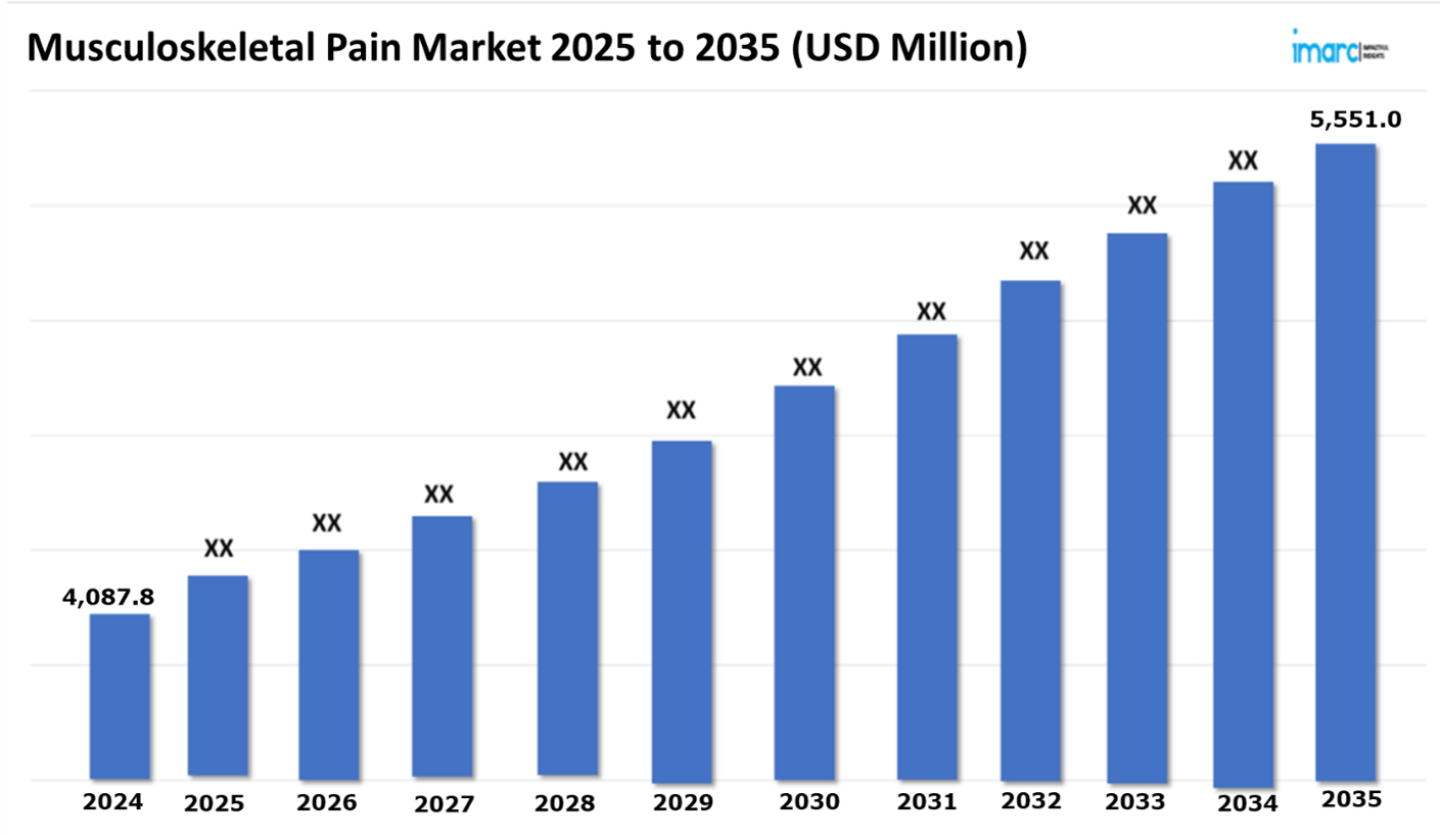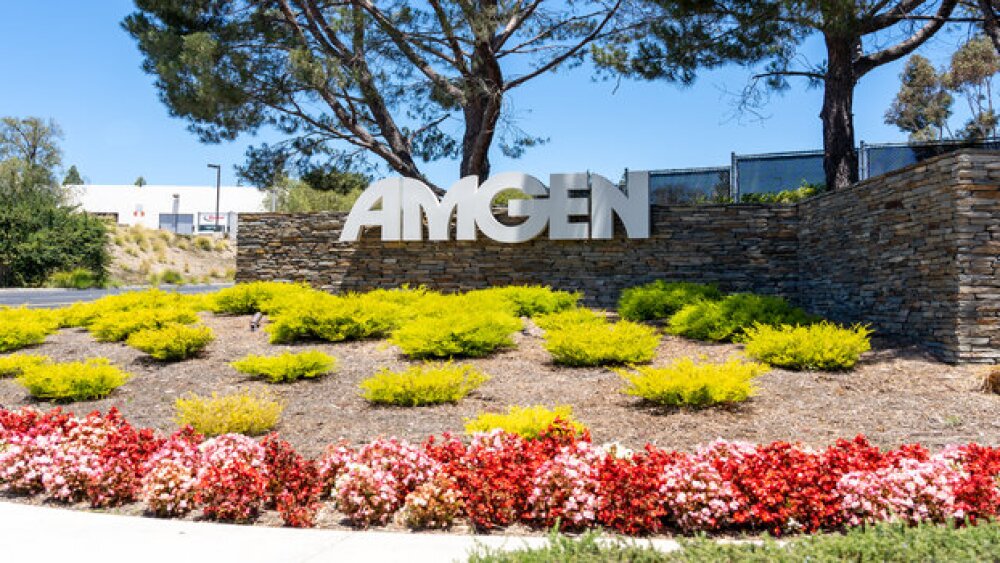Musculoskeletal Pain Market Outlook 2025-2035:
The 7 major musculoskeletal pain market reached a value of USD 4,087.8 Million in 2024. Looking forward, IMARC Group expects the 7MM to reach USD 5,551.0 Million by 2035, exhibiting a growth rate (CAGR) of 2.83% during 2025-2035. Increasing demand for mindfulness-based stress reduction techniques that can induce relaxation and provide benefits for the general well-being of patients is the driving force behind the market. Another factor further enhancing growth in the market is the development of targeted therapies and treatments.
Advances in Early Detection and Diagnostic Technologies: Driving the Musculoskeletal Pain Market
Advances in early detection and diagnostic technologies are the largest drivers of the musculoskeletal pain market. Some of the advanced developments in diagnostic technology include the improvement of imaging modalities. High-resolution magnetic resonance imaging, computed tomography scans, and musculoskeletal ultrasound have significantly enhanced the ability to detect early structural damage, inflammation, and tissue abnormalities in the joints, muscles, and bones. These imaging techniques allow clinicians to clearly see what causes musculoskeletal pain. Targeted intervention strategies are implemented based on better visualization. Functional imaging techniques, including PET, have also been proposed to assess inflammation and metabolic changes in affected tissues to gain insight into pain mechanisms. Biomarkers-based diagnostic tools are another promising development. More biomarkers regarding inflammation of the joints, degradation of cartilage, and remodeling of bones are used in detecting musculoskeletal conditions much earlier. This often means some sort of biomarker that would be detected by blood test without requiring invasive procedures for establishing whether there exist musculoskeletal disorders and even the extent at which they occur. Another aspect is the integration of artificial intelligence and machine learning algorithms in diagnostic tools, which is revolutionizing the early detection of musculoskeletal pain. AI-driven systems analyze imaging data and patient records to identify patterns and predict the likelihood of developing chronic pain or complications. These technologies have helped healthcare providers make faster, more accurate diagnoses thereby indirectly improving patient outcomes and driving the musculoskeletal pain market due to early intervention and better targeted treatments.
Request a PDF Sample Report: https://www.imarcgroup.com/musculoskeletal-pain-market/requestsample
Development of Novel Therapies and Pharmacological Treatments: Contributing to Market Expansion
The discovery of innovative drugs and medicinal treatments is hugely driving the market for musculoskeletal pain in terms of increased hopes for millions of patients across the globe to overcome chronic pain, such as osteoarthritis, rheumatoid arthritis, and low back pain. Disease-modifying drugs are one of the most important target areas for researchers since they aim toward the slowness of progression or sometimes even reversal of the actual musculoskeletal conditions. Biologic drugs like TNF inhibitors, interleukin inhibitors, and many more have become a popular treatment option for autoimmune musculoskeletal diseases such as rheumatoid arthritis. This class of biologics directly strikes at various pathways through which inflammation occurs, reducing joint damage and subsequently pain, and improving quality of life. Another interesting area is that of regenerative medicine. Among other approaches toward promoting tissue healing and repair with long-term benefits for people afflicted with conditions like osteoarthritis is the use of stem cell therapies, along with PRP injections that help regenerate one’s cartilage and regain joint function, resulting in fewer surgeries and a more natural process of pain relief. Targeted drug delivery systems, including transdermal patches and local injections, also advance the area of musculoskeletal pain treatment. Targeted therapy ensures that drugs can be delivered directly to the source of pain and locally injected. Patches applied through transdermal applications are more focused with better-controlled releases that ensure minimal side effects while achieving higher patient compliance. Furthermore, ongoing studies in the fields of personalized medicine and innovative pharmaceutical therapies hold bright prospects for continued market expansion. As novel treatments become increasingly available and effective, they are thereby facilitating improved patient outcomes while driving growth in both the pharmaceutical and healthcare sectors.
Buy Full Report: https://www.imarcgroup.com/checkout?id=8132&method=809
Marketed Therapies in Musculoskeletal Pain Market
Amrix (Cyclobenzaprine extended release): Adare Pharmaceuticals
Amrix (Cyclobenzaprine extended release) is used as a short-term (2-3 weeks) adjunct therapy. It is combined with rest and physical therapy to relieve muscle spasms caused by acute, painful musculoskeletal problems. Cyclobenzaprine works at the supraspinal level. It specifically focuses on the locus coeruleus of the brainstem, with little or no activity at neuromuscular junctions or on skeletal muscle. Action on the brainstem is thought to result in reduced activity of efferent alpha and gamma motor neurons, most likely mediated via inhibition of coeruleus-spinal or reticulospinal pathways, and eventually depressed spinal cord interneuron activity.
Cymbalta (Duloxetine): Eli Lilly and Company
Cymbalta is a serotonin and norepinephrine reuptake inhibitor (SNRI) used to treat chronic musculoskeletal pain. Cymbalta treats musculoskeletal pain through its dual mechanism of action. It inhibits the reuptake of serotonin and norepinephrine, two neurotransmitters involved in pain modulation. By increasing the levels of these neurotransmitters in the brain and spinal cord, Cymbalta enhances the body’s ability to regulate pain signals. This helps reduce pain perception, particularly in conditions like chronic lower back pain and osteoarthritis. The drug’s action on both serotonin and norepinephrine pathways contributes to improved pain relief, making it an effective treatment for musculoskeletal pain and related conditions.
Leading Companies in the Musculoskeletal Pain Market:
The market research report by IMARC encompasses a comprehensive analysis of the competitive landscape in the market. Across the global musculoskeletal pain market, several leading companies are at the forefront of developing integrated platforms to enhance the management of musculoskeletal pain. Some of the major players include Adare Pharmaceuticals and Eli Lilly and Company. These companies are driving innovation in the musculoskeletal pain market through continuous research, diagnostic tools, and expanding their product offerings to meet the growing demand for the illness.
Request for customization: https://www.imarcgroup.com/request?type=report&id=8132&flag=E
Key Players in Musculoskeletal Pain Market:
The key players in the Musculoskeletal Pain market who are in different phases of developing different therapies are Adare Pharmaceuticals, Eli Lilly and Company, and Others.
Regional Analysis:
The major markets for musculoskeletal pain include the United States, Germany, France, the United Kingdom, Italy, Spain, and Japan. According to projections by IMARC, the United States has the largest patient pool for musculoskeletal pain while also representing the biggest market for its treatment. This can be attributed to the growing aging population, as musculoskeletal disorders such as osteoarthritis, osteoporosis, and back pain are more prevalent among older adults.
In addition, lifestyle-related conditions such as obesity and sedentary behavior have increased in prevalence, increasing musculoskeletal pain further. There are many causes for joint and muscle aches such as bad posture, no exercise, and bad diet, all significant in bringing individuals into the pain management therapy range. All these factors have greatly extended the need for effective treatments.
Apart from this, the newer treatment methods like biologics, regenerative therapies, such as stem cell therapy, and targeted drug delivery systems are less invasive modes of pain management that could be more effective. These newer options have opened the scope of treatment and outcomes and, hence, increasing demand for such treatments in the market.
Key information covered in the report.
Base Year: 2024
Historical Period: 2019-2024
Market Forecast: 2025-2035
Countries Covered
- United States
- Germany
- France
- United Kingdom
- Italy
- Spain
- Japan
Analysis Covered Across Each Country
- Historical, current, and future epidemiology scenario
- Historical, current, and future performance of the musculoskeletal pain market
- Historical, current, and future performance of various therapeutic categories in the market
- Sales of various drugs across the musculoskeletal pain market
- Reimbursement scenario in the market
- In-market and pipeline drugs
Competitive Landscape:
This report offers a comprehensive analysis of current musculoskeletal pain marketed drugs and late-stage pipeline drugs.
In-Market Drugs
- Drug Overview
- Mechanism of Action
- Regulatory Status
- Clinical Trial Results
- Drug Uptake and Market Performance
Late-Stage Pipeline Drugs
- Drug Overview
- Mechanism of Action
- Regulatory Status
- Clinical Trial Results
- Drug Uptake and Market Performance
Ask Our Expert & Browse Full Report with TOC: https://www.imarcgroup.com/musculoskeletal-pain-market/toc
IMARC Group Offer Other Reports:
Chronic Lower Back Pain Market: The 7 major chronic lower back pain markets reached a value of US$ 6.7 Billion in 2023, and projected the 7MM to reach US$ 10.0 Billion by 2034, exhibiting a growth rate (CAGR) of 3.7% during 2024-2034.
Muscle Spasticity Market: The 7 major muscle spasticity markets reached a value of US$ 3.3 Billion in 2023, and projected the 7MM to reach US$ 6.9 Billion by 2034, exhibiting a growth rate (CAGR) of 6.84% during 2024-2034.
Inflammatory Pain Market: The 7 major inflammatory pain markets reached a value of US$ 68.3 Billion in 2023, and projected the 7MM to reach US$ 89.3 Billion by 2034, exhibiting a growth rate (CAGR) of 2.46% during 2024-2034.
Chronic Pain Market: The 7 major chronic pain markets reached a value of USD 21.8 Billion in 2024. Looking forward, IMARC Group expects the 7MM to reach USD 29.9 Billion by 2035, exhibiting a growth rate (CAGR) of 2.90% during 2025-2035.
Acute Pain Market: The 7 major acute pain markets reached a value of USD 83.5 Million in 2024. Looking forward, IMARC Group expects the 7MM to reach USD 129.8 Million by 2035, exhibiting a growth rate (CAGR) of 4.09% during 2025-2035.
Spinal Disorders Market: The 7 major spinal disorders markets reached a value of US$ 5.1 Billion in 2023, and projected the 7MM to reach US$ 7.1 Billion by 2034, exhibiting a growth rate (CAGR) of 3.09% during 2024-2034.
Contact US
IMARC Group
134 N 4th St. Brooklyn, NY 11249, USA
Email: Sales@imarcgroup.com
Tel No:(D) +91 120 433 0800
Phone Number: - +1 631 791 1145, +91-120-433-0800






